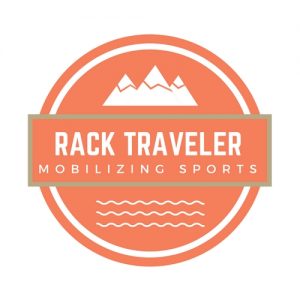
Getting a roof rack opens up a world of possibilities for transporting gear on your vehicle. But with so many options on the market, it can be tricky to determine exactly what you need. This comprehensive guide covers everything you need to consider when shopping for the right roof rack – from measuring your vehicle and weight limits to selecting rack types, materials, mounting styles, and more. Follow these tips to find the perfect rack for your needs and budget.
“The key factors to think about when buying a roof rack are your vehicle make and model, weight capacity needs, rack style preference, and budget.” – James Cooper, GearVault Outdoor Outfitters
Know Your Vehicle
The first step is knowing the specifics of your vehicle. This determines compatibility and weight limits for roof racks. You’ll need to know:
- Make, model and year – ensures correct fit.
- Style – sedan, SUV, crossover, etc. Impacts options.
- Roof construction – materials affect mounting.
- Dimensions – measure roof length and width.
- Sunroof/rails – affects rack compatibility.
- Door access – swinging rear doors need adjustable rack position.
- Max roof weight – don’t exceed vehicle rating.
- Garaged clearance – measure garage interior height.
Consult your owner’s manual or contact the dealer to confirm specs. Measure the roof dimensions rather than relying on stats alone. This ensures proper rack sizing and position.
Consider Weight Limits
Roof racks have maximum weight ratings you must adhere to:
| Weight Type | Definition |
|---|---|
| Static limit | Max weight bearing while parked |
| Dynamic limit | Max weight while vehicle is in motion |
| Load limit | Total max load including rack weight |
Exceeding these limits risks damage to your vehicle and serious accidents. Consider not just the gear weight itself but also:
- Weight of the roof rack (15-25 lbs)
- Additional passengers and cargo inside the vehicle
Driving speed impacts limits too – exceeding 55 mph drastically reduces dynamic weight capacity. Overall it’s smart to keep total load under 100 lbs if frequently driving on highways.
Pick Rack Type
There are 5 main roof rack types that each serve different purposes:
Cross Bars

- Low profile rounded metal bars
- Require towers, clips, mounts to attach to car
- Used alone or as base for accessories
- Ideal for transporting long awkward items like ladders or lumber
Cargo Baskets
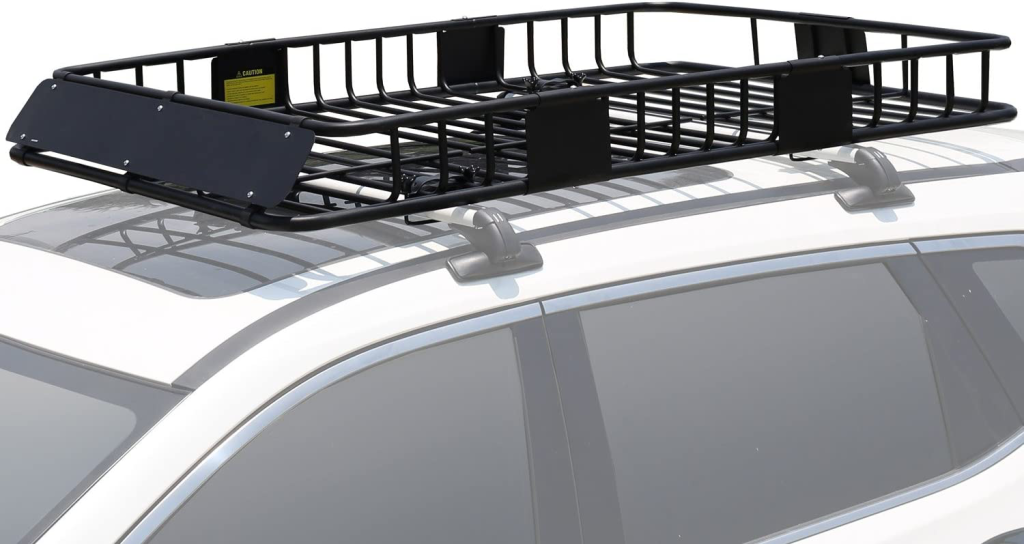
- Metal mesh baskets attach to crossbar base
- Quick access for bulky cargo with tie-down points
- Versatile and protective but noisy
- Ideal for odd-shaped items or dirty/wet gear
Cargo Boxes
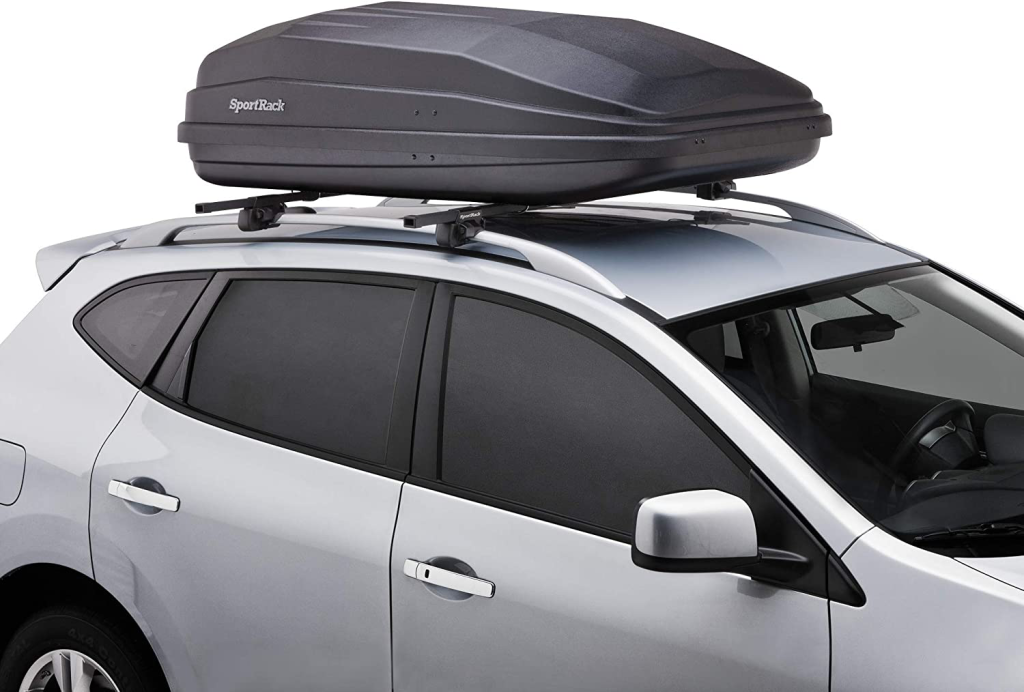
- Lockable plastic containers keep gear enclosed
- Aerodynamic, protective, waterproof
- More loading flexibility than baskets
- Ideal for luggage, delicate items, valuables
Ski/Snowboard Racks
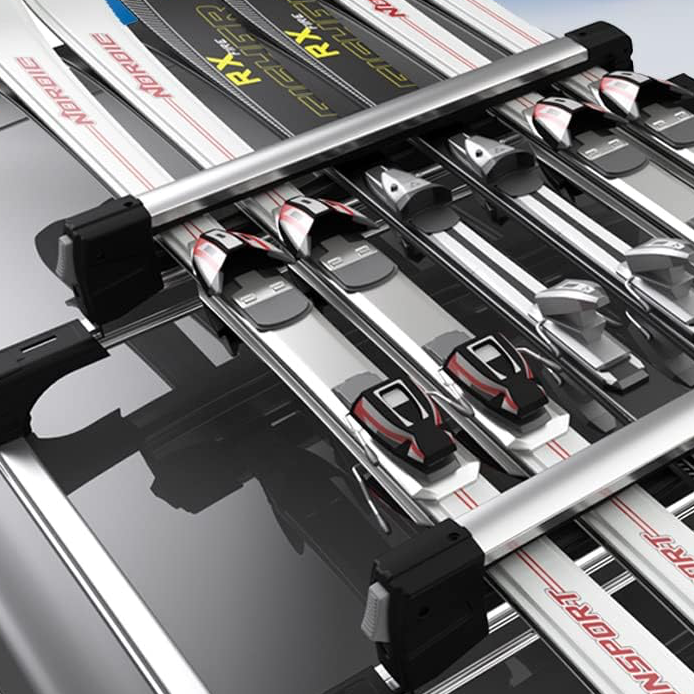
- Fixed clamps hold skis or boards securely
- Padded to prevent damage
- Models for different ski/board amounts
- Ideal winter sports transportation
Kayak/Surf/Canoe Racks
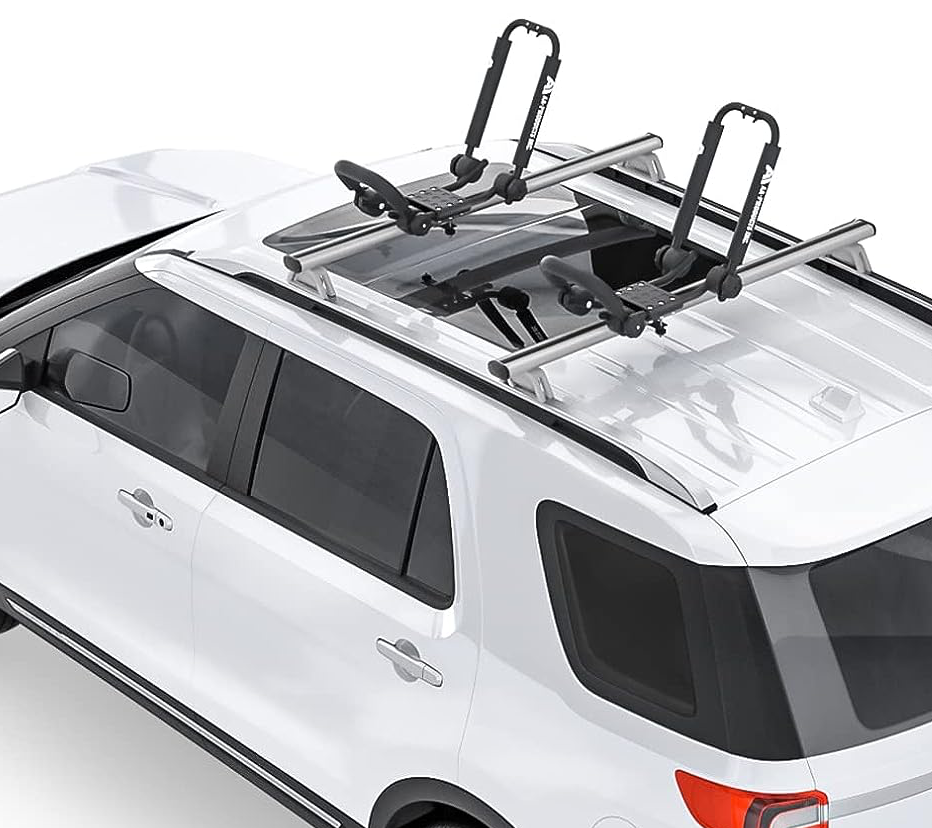
- Cradles or J-hooks hold watercraft securely
- Rubber pads prevent hull scuffs/abrasion
- Models for 1-3+ boats available
- Ideal for transporting water sports gear
Consider which activities you’ll use the rack for most when choosing a type. Many racks can be outfitted with different accessories like bike attachments or cargo baskets too.
Select Material
Roof racks come in 3 main material options:
| Material | Pros | Cons |
|---|---|---|
| Stainless Steel | Strongest, most durable | Heaviest, expensive |
| Aluminum | Lightweight, corrosion-resistant | Can dent/scratch easier |
| Plastic | Cheapest, fairly durable | Not as strong, can crack |
- Stainless steel offers the most strength for heavy loads but weighs more. Popular for cargo baskets.
- Aluminum strikes a nice balance between durability and weight savings. Used for crossbars and boxes.
- Plastic racks like kayak cradles are lightest yet not as impact resistant. Budget-friendly option.
Consider how much wear-and-tear the rack will endure based on your usage needs. Steel is best for aggressive off-road driving while plastic keeps costs down for occasional use.
Pick Mounting Style
There are 2 main ways roof racks attach to your vehicle:
Cross Bar Mounted
- Bars attach directly to towers/clips/hooks on vehicle
- Towers bolt into door jambs or use clamps/suction cups
- Minimal parts, but may require drilling holes
- Best for cars without rails, adjustable positions
Pros
- Versatile fit and positioning
- Lower profile without rails
- Often easier to install
Cons
- May involve drilling into roof
- Less weight capacity than rail mounts
- More noise/wind resistance
Rail Mounted
- Bars attach using adapters on factory rails
- No new holes drilled into car
- Limited by rail position/length
Pros
- No new drilling required
- Often has greater weight limit
- Uses existing mounting points
Cons
- Limited positioning flexibility
- Only works with roof rail cars
- Rail adapters can add cost
Look at your roof to see if you have factory rails or not to determine the best mounting option.
Key Features to Look For
- Wind fairing – deflects wind under the rack to reduce noise.
- Locking mechanism – secures rack and cargo from theft.
- Padding/boat hull protection – prevents dents, scratches.
- Adjustable mounting towers – provides flexible placement.
- Tool-free installation – quick and easy DIY mounting.
- Warranty – protects against defects; 5-year average.
Don’t overlook small details that improve function and convenience like locks, padding, and tool-free parts. These features separate higher quality racks from budget POS models.
Compare Popular Roof Rack Brands
The top manufacturers each offer their own take on rack technology and features:
| Brand | Overview | Prices |
|---|---|---|
| Yakima | Known for kayak and cargo boxes. Excellent warranties. Aerodynamic designs. | $$$ |
| Thule | Industry leader in innovation and quality materials. Stylish designs. | $$$ |
| Rhino Rack | Focus on function over form. Durable and reliable performance. | $$ |
| INNO Rack | Budget-friendly prices with decent quality and durability. | $ |
| Malone | Specializes in kayak, paddleboard racks. Great value. | $$ |
Do your research to see what brands excel for your intended activities. Yakima and Thule lead in cutting-edge features while INNO Rack or Malone keep costs lower.
Measure Twice, Install Once
Careful measuring ensures ordering the right size rack parts and smooth installation:
- Measure roof width at front and rear ends
- Note lowest garage clearance height
- Account for angles if rear door slopes
- Check crossbar spread limit in manual
- Have helper assist with test fitting
Don’t assume manufacturer size charts are 100% accurate. Vehicle variances happen. Test fit components when possible before fully installing.
“Trying to install a rack that doesn’t actually fit your car is a nightmare. Small measurement differences can mean reordering or returning parts. Always measure twice yourself for a proper hassle-free installation.” – James Walters, ASW Automotive
Installation Tips
Follow these pointers for easier roof rack installation:
- Use vehicle-specific instructions only
- Start with crossbar towers first
- Tighten bolts gradually and evenly
- Torque bolts with calibrated wrench
- Check tightness after initial drive
- Coat steel bolts with grease to prevent rust
Take care not to overtighten bolts which risks cracking the roof surface. Refer to torque specs in the manual and use a calibrated torque wrench for proper tightening.
Roof Rack Pricing
Expect to spend $150 to $700+ on a roof rack depending on quality:
| Type | Price Range |
|---|---|
| Crossbars | $80 – $350 |
| Cargo Baskets | $150 – $230 |
| Cargo Boxes | $400 – $900 |
| Kayak Racks | $120 – $170 |
| Ski/Snowboard Racks | $90 – $400 |
You can build a basic bare-bones crossbar system for around $150. High-end cargo boxes and kayak racks run $650+ for premium brands. Shop sales to save on clearance rack models from last season.
Maintenance Tips
Regular cleaning and checks will maximize your roof rack’s lifespan:
- Rinse with water after beach or mud trips
- Tighten bolts if rattling develops
- Check plastic parts for cracks annually
- Re-grease steel bolts as needed
- Avoid automated car washes
- Remove rack when storing vehicle long term
Modern finishes resist rust and corrosion much better, but still benefit from occasional cleaning. Avoid harsh detergents or abrasive pads which may dull or scratch the finish.
Ready to Hit the Road
Equipping your ride with a solid roof rack opens the doors to new adventures. Use this guide to find the perfect match based on your vehicle specifics, cargo needs, budget and rack preferences. Take care to measure properly, calculate weight capacities, and install securely. Then get ready to load up and take on any adventure in style with your newfound cargo space!
